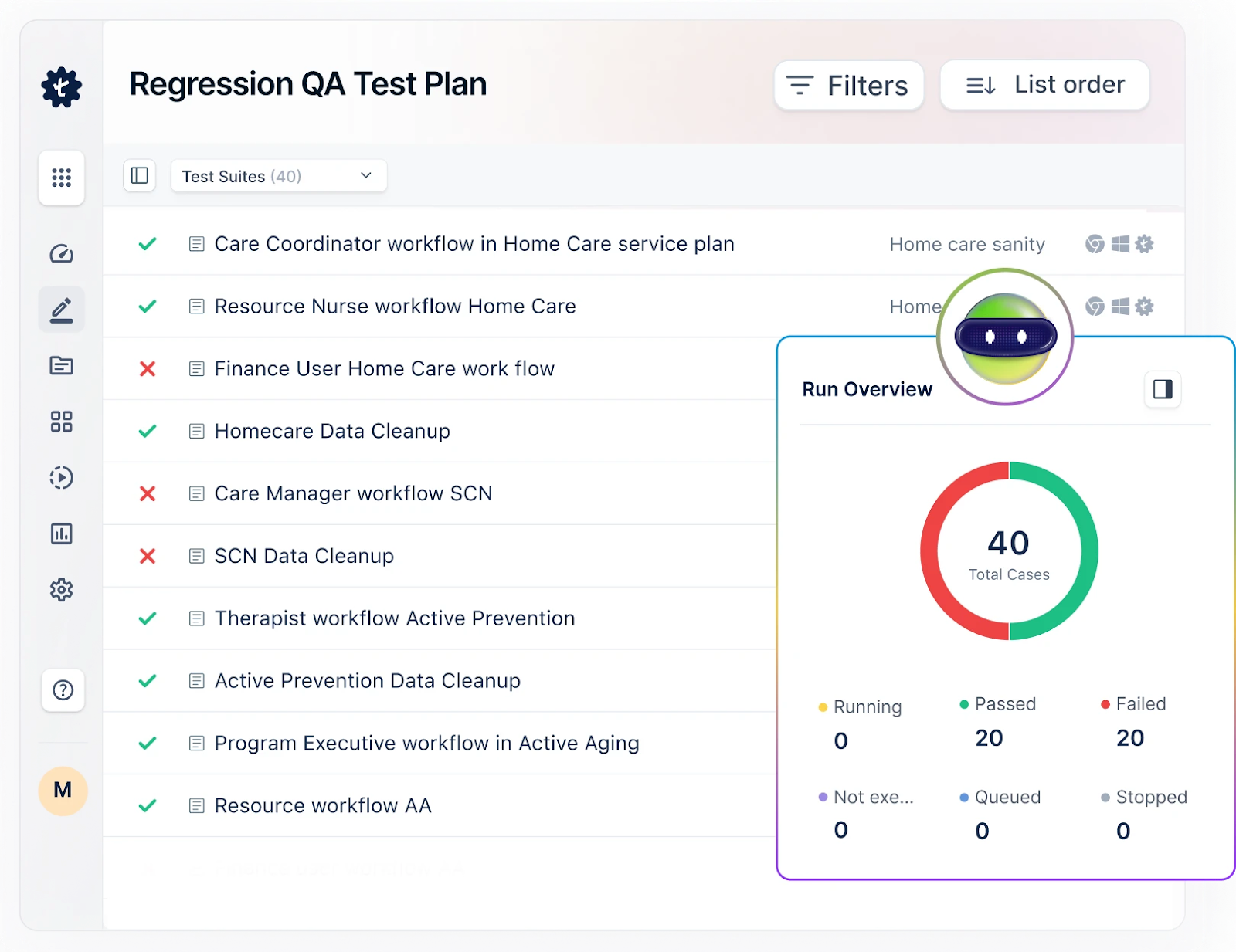Regression testing verifies that any change in code does not impact existing application functionality. Manual regression testing can be time-consuming and costly due to repetitive and frequent retesting. Automated regression testing tools simplify this process by handling repetitive tests without manual effort.
Statistics state that 50.5% of QA teams automate regression testing to boost efficiency and reduce manual workload. Modern trends like codeless automation allow testers to create tests easily using natural language, while AI-powered features further reduce maintenance and speed up release cycles.
In this article, we have listed the top regression testing tools of 2025 that QA teams highly consider.
Table Of Contents
- 1 What Are Regression Testing Tools?
- 2 Factors To Consider When Choosing The Best Regression Testing Software for Your Team
- 3 10 Best Automated Regression Testing Tools
- 4 Key Comparison Table – Top 5 Regression Testing Tools
- 5 Conclusion
- 6 Frequently Asked Questions
What Are Regression Testing Tools?
Regression testing tools are software applications that automate the process of re-running test cases after code changes. They help ensure that new updates, bug fixes, or features don’t accidentally break existing functionality.
These tools streamline the regression testing process, making it faster and reliable than manual retesting, and support agile teams working with frequent code changes.
Factors to Consider When Choosing the Best Regression Testing Software for Your Team
When you’re on a hunt for an automated regression testing tool for your project, you will have to take a look at these key factors and ensure that the tool aligns with them:
Factor #1: Simple yet Efficient Test Creation
Creating tests needs a proper understanding of the application under test (AUT) and strategic thinking. The time taken to create tests varies depending on the complexity of the application and the testing approach. Does your regression testing tool simplify the test creation process?
Factor #2: Faster Test Execution
The core reason for shifting from manual to automation for regression testing is speed. Is your tool capable of accelerating your testing?
Factor #3: Easy Test Maintenance
When the application undergoes code changes, the test cases must also be updated accordingly. So, does your tool simplify test case/script update and maintenance?
Factor #4: Self-Healing Capability
How easy is it to update your tests if your applications go through changes? Does the tool have a built-in self-healing feature to minimize test failures after the application changes?
Factor #5: 24×7 Technical Support
Does the platform provide extended support for technical queries? Customer support is a major concern for most teams, as many testing platforms lack proper, active technical support.
10 Best Automated Regression Testing Tools
There are various regression testing frameworks and tools available in the market that cater to different testing needs. The following list explores the best tools for regression testing with their most celebrated features. Please note that they are not in order or priority or any other ranking.
Testsigma
The first tool that comes to mind while dealing with automation challenges is Testsigma. It is a codeless, cloud-based, Agentic AI-driven test automation platform that allows QA teams to automate web, mobile, API, SAP, Salesforce, and desktop app testing.
Testsigma is a unified testing tool that provides an intuitive yet powerful visual interface to automate regression tests and other functional tests for different application types from the same platform. Along with regression testing, the platform lets you automate every major testing type, including integration testing, UI testing, cross-browser testing, etc.
You can write test scripts in plain English, which makes it easier for tech and non-tech team members. When it comes to regression testing, Testsigma makes the testing process 10X faster, helping you ship products quickly. With features spanning from integrations of CI/CD and DevOps pipelines to incorporating in-sprint automation principles, Testsigma is a complete solution for all your regression testing needs.
Here is a quick look at the factors we discussed above,
Factor #1: Simple yet Efficient Test Creation
Testsigma allows you to create test cases using simple English with the support of NLP-Engine or AI agents. This codeless testing tool makes testing accessible for everyone on the team. You can quickly create test cases without writing any code using the low-code testing approaches supported by the platform, such as NLP-based testing, Recorder, Generator Agent, or Testsigma Copilot.
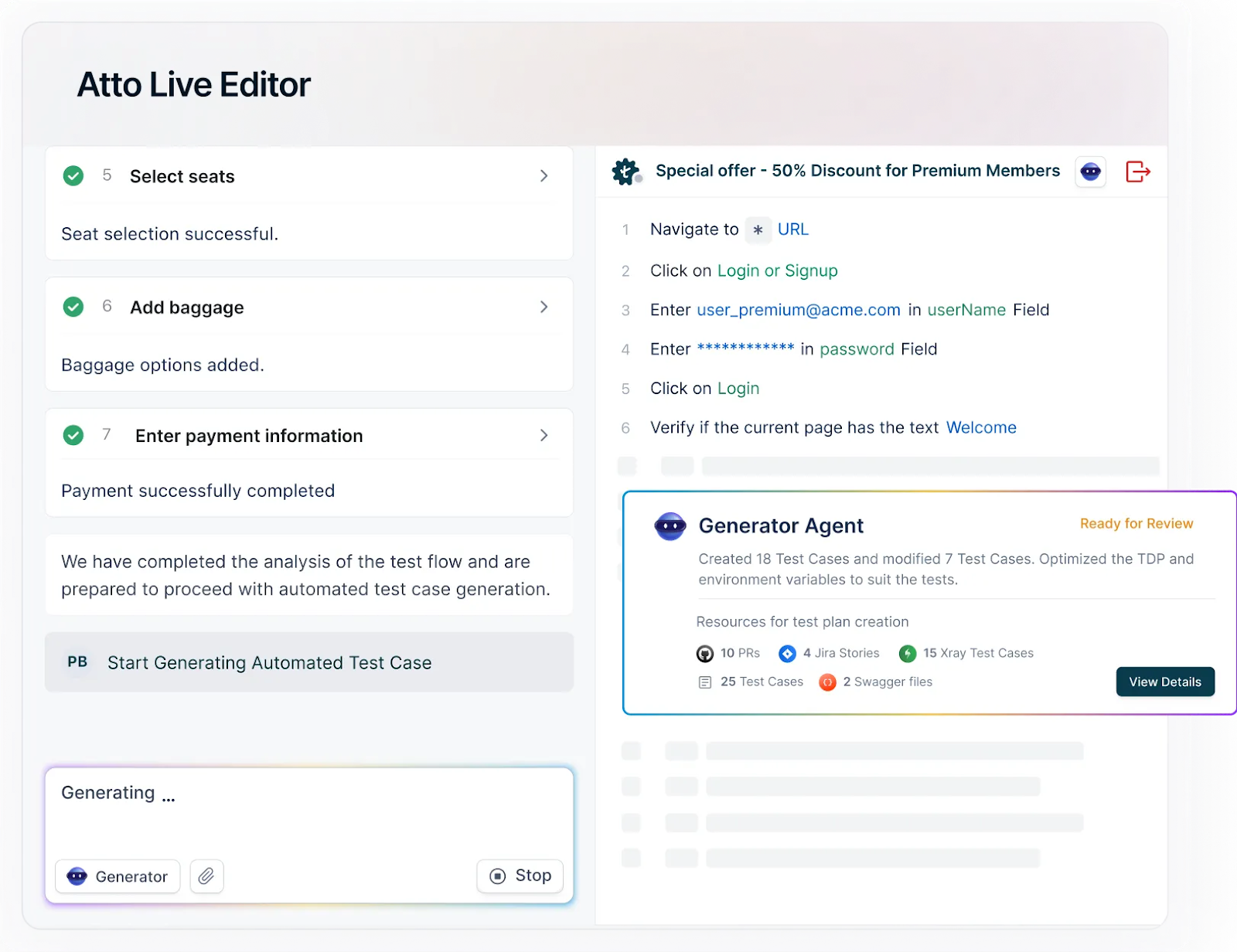
It is the only tool that supports code-based (Java) and codeless testing in one place, making it easy for both technical and non-technical users to collaborate efficiently for testing. It significantly reduces test authoring time compared to the traditional automation approaches.
Since it is a low/no-code platform, you don’t have to worry about spending on training and onboarding testers. The documentation, tutorials, and community support make the learning process easier. Ultimately, it helps save heaps of time, effort, resources, and money.
Factor #2: Faster Test Execution
Like test case creation, test execution is also faster with this platform. You can execute tests at lightning speed with just a few clicks. Parallel testing is another perk that boosts the test execution speed. You can quickly run multiple tests across multiple test environments simultaneously. Using the real device cloud, you can run regression tests across 3000+realdevices/browser/OS combinations. This makes cross-browser testing, portability testing, compatibility testing, and responsive testing easier for web, mobile, API, and desktop apps.
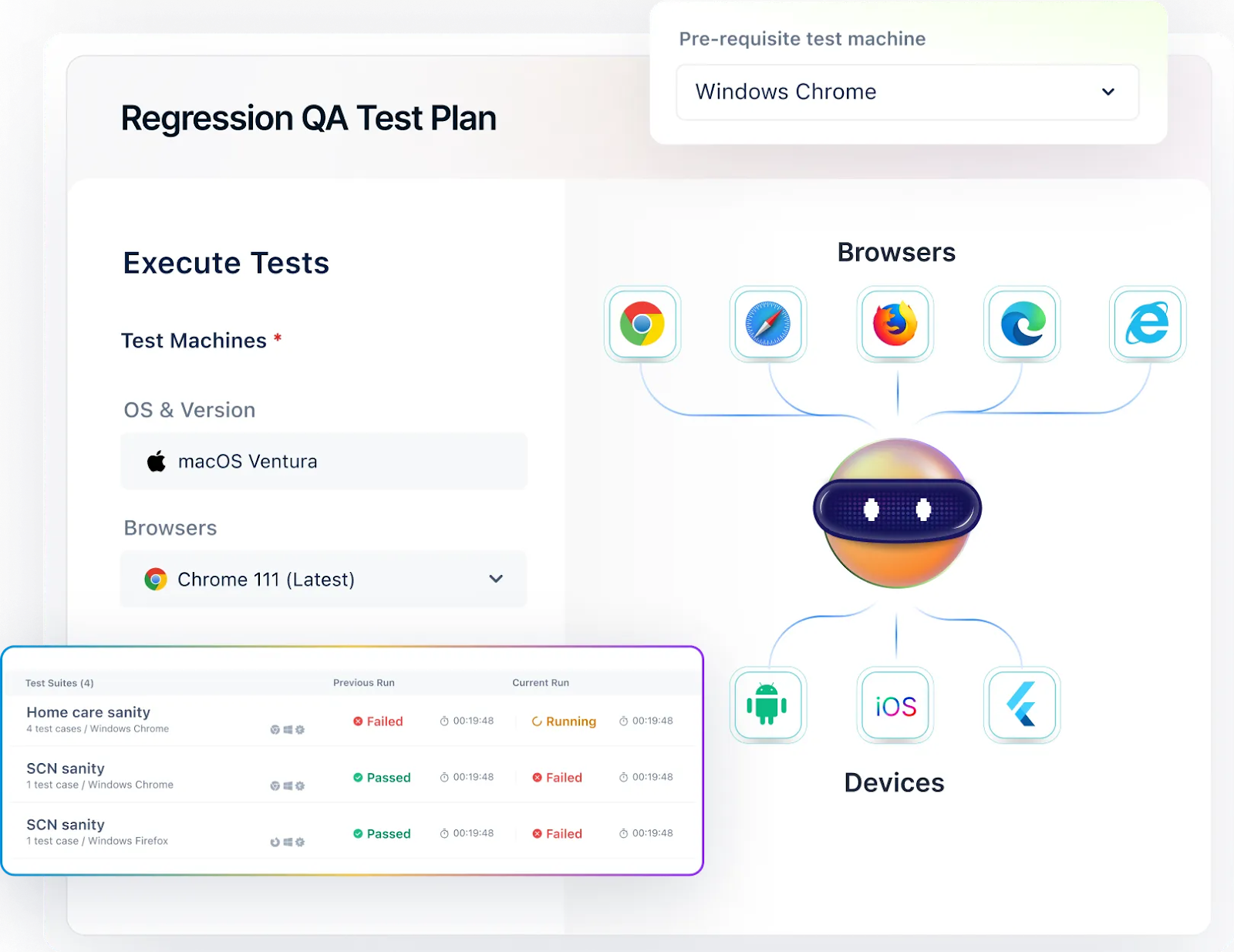
Also, testers need not worry about test report generation. Testsigma provides custom and detailed test reports after every test run. This accelerates the feedback loop with the developers and makes the testing process even more efficient. It speeds up the release cycles and helps ship faster.
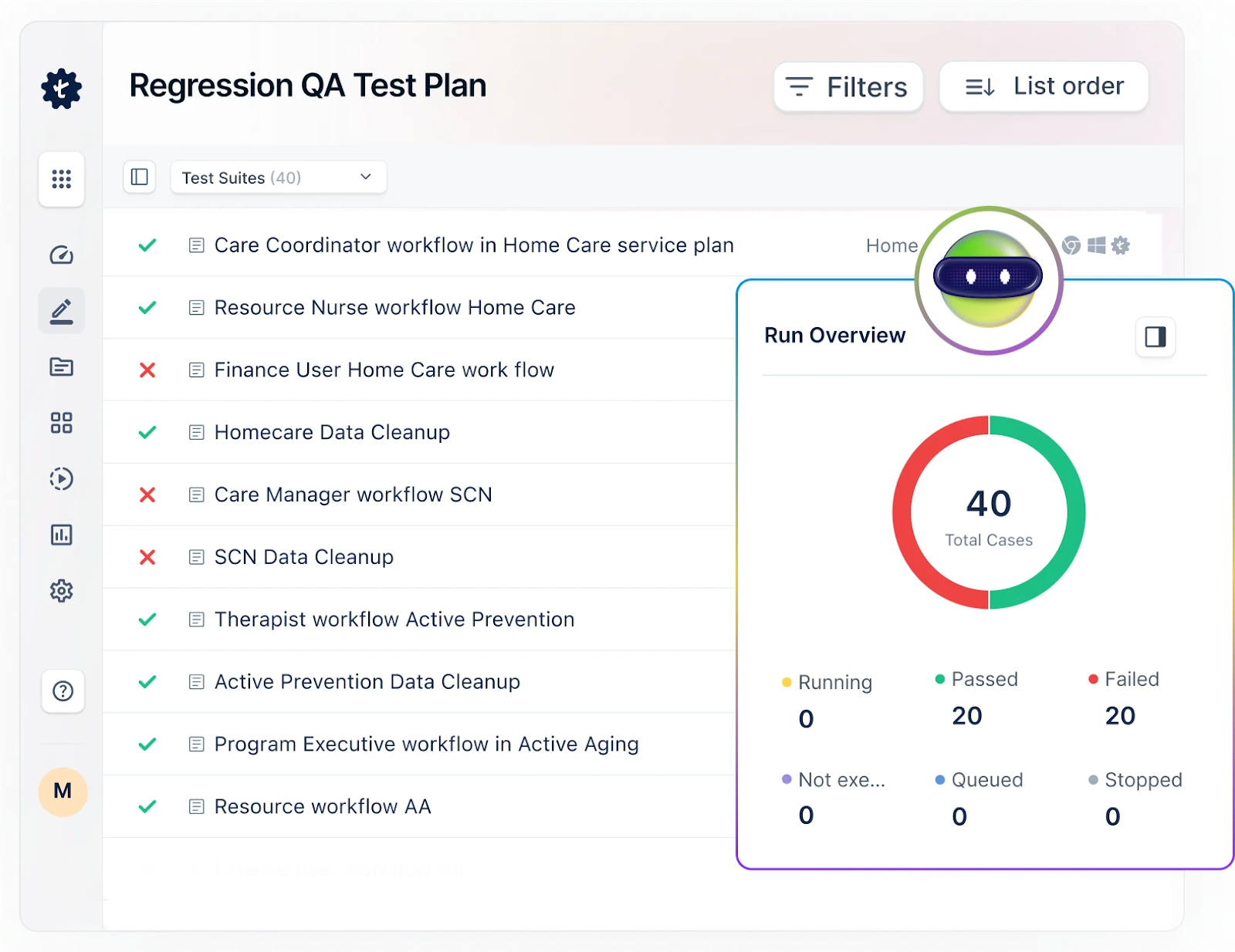
By incorporating regression tests into CI/CD, every commit triggers automated validation across builds, catching defects early and reducing production risks.
Factor #3: Easy Test Maintenance
Test maintenance is a daunting process when you handle complex and large applications. With every code or bug fix, you will have to edit the test cases to align with the project. Editing code-based test scripts is a challenging task, as you will have to understand the code and then update your scripts every time.
This gets more complicated when new testers join the team. Also, testers must be highly skilled in the programming language used to create test scripts.
But Testsigma simplifies the test maintenance process. You can easily edit and maintain test cases on the cloud. Since the test cases look similar to the natural language, automated testing is easier for new testers or other stakeholders on the project.
Factor #4: Self-Healing Capability
Testsigma supports AI-driven auto-healing capability to prevent or debug test failures. How does this feature help keep your test cases stable and reliable? Let me simplify.
In several cases, the test case fails due to changes to the object properties, which might cause the entire test run to collapse. As you might know, there are several ways to identify web elements, such as element ID, name, XPath, etc. When the UI changes, chances are these might also change, which might ultimately lead to breaking up your test cases. That’s where Testsigma’s auto-healing feature helps. It self-heals the test cases by automatically updating the elements without breaking them.
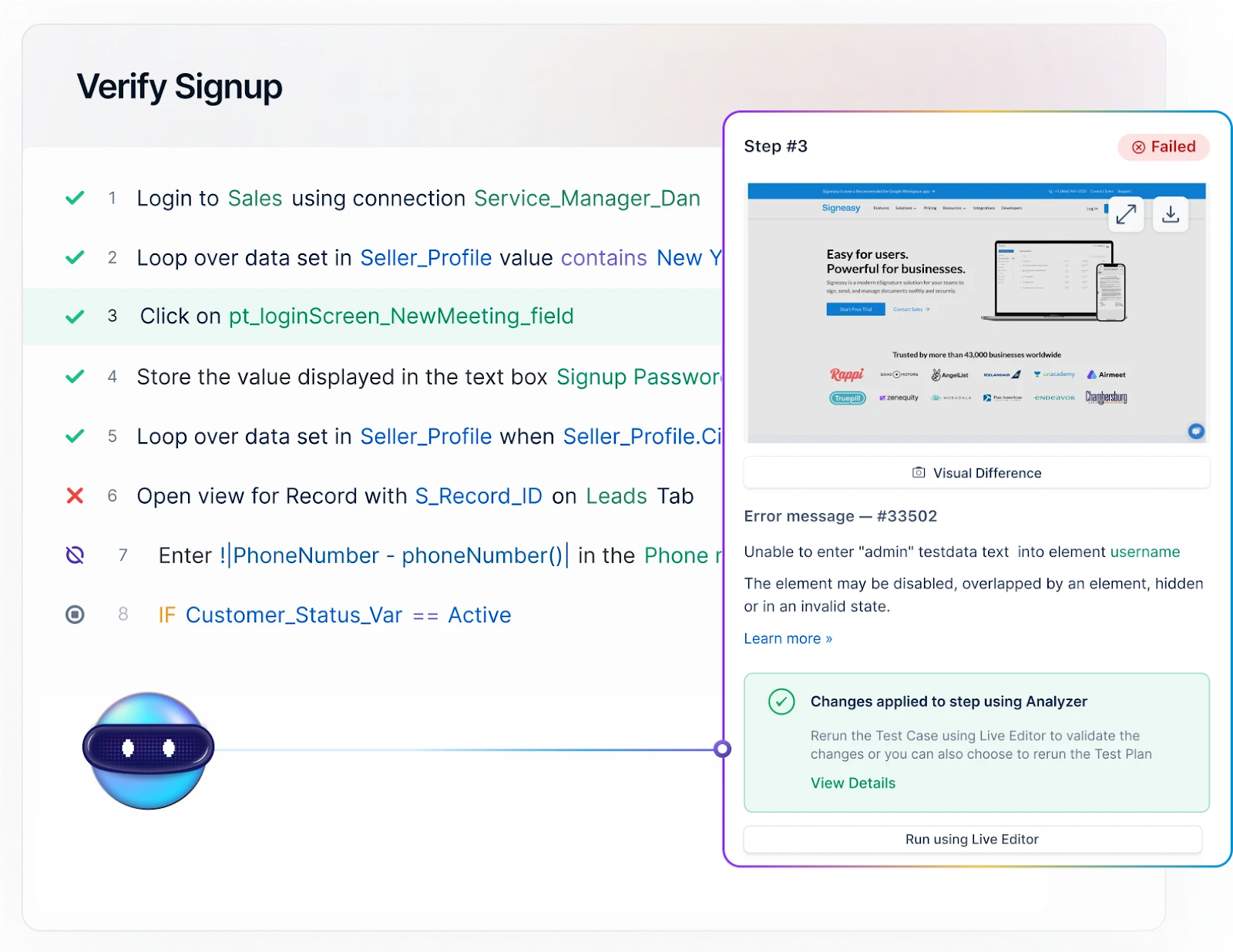
Factor #5: 24×7 Technical Support
Testsigma is the only tool that offers 24/7 customer support via chat, call, email, and community. This is a crucial advantage for companies when they need tech support at lightning speed. Instead of waiting for someone to answer queries on larger testing communities over the internet, you can get in touch with their tech support team for any support needed.
Selenium

Selenium is a popular open-source test automation framework that supports web testing. It provides a strong automation library with methods that are easy to implement and execute on various browsers. Selenium holds a little over 45% of the market share and has been in the market for many years now. It helps enable regression automation, which executes test cases automatically and faster than manual methods.
Selenium supports all the major platforms. Also, it supports the execution of multiple tests at once using Selenium Grid. Since Selenium is only for web app testing, you will have to opt for other testing tools for automated mobile app testing.
Let’s take a quick look at the factors,
- Factor #1: Selenium is a script-based testing framework and is popular for its long list of programming language support. You can create code scripts using any of the languages supported. However, testers require strong coding skills to create test scripts. Also, understanding, updating, or maintaining these test scripts gets daunting when a new tester takes over.
- Factor 2#: Is test execution faster? Not as fast when compared with tools like Testsigma. That is because you need to install multiple tools and libraries to create and run Selenium tests.
- Factor 3#: Is test maintenance easy with Selenium? No, it isn’t, as you will have to rewrite the test scripts every time the UI or code changes.
- Factor 4#: Does it provide any built-in feature to prevent test failures? No, Selenium does not offer AI-driven capabilities.
- Factor 5#: Does it provide extended technical support? Selenium has a very active and large community for any technical queries. But extended support, no.
TestRigor

testRigor works on the same principles of codeless test automation as Testsigma listed above. Using the English language as the medium of instruction, testRigor enables manual testers to write and execute automation tests without any additional effort.
testRigor comes with its own Google Chrome extension that can capture the actions done on a web application and convert them to test cases.
A quick look at the factors,
- Factor #1: You can create tests using plain English, like Testsigma. English-based test cases are easy to read, and therefore, non-technical people like stakeholders can also provide their input.
- Factor #2: It claims to make the test execution faster.
- Factor 3#: Having English as the script language has the biggest advantage of reducing the maintenance of the tests.
- Factor #4: Yes, it offers self-healing capabilities.
- Factor #5: It offers support through Slack and MS Teams.
Sahi Pro

Sahi Pro is a complete regression test automation tool to help build regression tests for web-based applications, mobile apps, and desktop applications. Sahi Pro is lightweight and can be used by people without technical knowledge as well.
It provides a spreadsheet-like interface where the tester or other persons can define the steps of the business flow. Once done, they can use the Sahi Pro recorder to record the interactions and create tests out of it. They can later be used for refinements and adding more value, preferably through data.
Let’s take a quick look at the factors,
- Factor #1: It provides a Recorder that works across most browsers, desktop, and mobile applications.
- Factor #2: To analyze the test results in-depth, detailed reports with graphical representations are presented that include summaries of execution as well. It helps quickly debug failures in regression tests and maintain them easily.
- Factor 3#: When there is a code change, use the Recorder to automatically go to that particular point and record the new step, making test maintenance easy with much effort required.
- Factor #4: Yes, it has self-healing capabilities that prevent test failures.
- Factor 5#: Provides technical support via email and phone.
With all these benefits, Sahi Pro stands to be a good regression testing tool with an open-source nature. However, the open-source free version comes with very basic testing features that may not be able to fulfill your requirements every time. This is one of the downsides that should be kept in mind before finalizing this tool.
IBM Rational Functional Tester

If there is something that does not care about the type of application you have and can provide automation regression testing capabilities to everything is the IBM rational functional tester. Its vast range includes .Net, Java, and even terminal-based applications. It is popularly used in regression and GUI testing and is often referred to as a “rational functional tester”.
Since this tool is owned by IBM, it will provide seamless integrations across other IBM applications. This could be really helpful as a lot of work can be accomplished from a single screen rather than juggling between tools.
- Factor #1: Though the tool provides a record-and-playback feature, it helps technically advanced QA teams to write code faster. So, testers are required to have strong coding skills in order to use the platform.
- Factor 2#: You can execute automated functional tests for web-based applications, including Java, .Net, Siebel, PowerBuilder, terminal emulator-based applications, and SAP.
- Factor 3#: The ScriptAssure technology helps in keeping tabs on user interface changes. Hence, the changes can be easily tracked and modified in the scripts which in turn brings down the maintenance overheads.
- Factor 4#: IBM does not provide any built-in feature to prevent test failures.
- Factor 5#: It provides basic community support that is available for free for all the clients. Only their enterprise clients get to use their 24×7 customer support.
Katalon Studio

Katalon Studio is a low-code, easy-to-use, complete test automation tool that takes care of not only regression testing but the phases before and after it. The tool is built on top of Selenium and Appium, which ultimately brings their advantages, too, when we use Katalon.
It provides an integrated development environment for advanced script writing and execution. Also, it is compatible with lots of integrations and pipeline third-party tools.
Let’s take a quick look at the factors,
- Factor #1: Katalon supports low-code test creation, which is perfect for testers with basic programming skills. It provides an Object Spy feature that allows testers to capture test objects or use the built-in keywords to write test cases. For advanced and custom test scripts, Katalon provides an ID with features like code suggestion, syntax highlighting, and a debugger.
- Factor 2#: It can be a bit slower when you have long test cases with hundreds of steps to execute. That is because Katalon uses Groovy, which is built on top of Java, and it needs to load many libraries to parse test data and objects.
- Factor 3#: The tool comes with an in-built advanced debugger that helps debug errors in scripts faster than conventional methods. This helps reduce the test maintenance efforts.
- Factor #4: Katalon Studio provides self-healing tests that are automatically validated when there is a change or broken object.
- Factor 5#: It offers support via its website and forum
Watir

Web Application Testing in Ruby, or simply Watir is a library for automating test cases written for Ruby applications. It is open-source in nature and is available as a RubyGems gem. For someone working on Ruby-based applications, WATIR is one of the most interesting libraries due to its nature of executing tests similar to how people operate on a web application. Recently, Watir webdriver was also introduced in the same series of library ecosystems.
People who do not want to work in Ruby or have experience in Python can also use its Python implementation called Nerodia. It is powered by Selenium but is in a very early stage.
Let’s take a quick look at the factors,
- Factor #1: It supports Ruby for test case creation. Also, it can only be used to automate browser interactions for web applications.
- Factor 2#: Since Watir is built on top of Selenium WebDriver, it is a bit faster as it directly interacts with the browser.
- Factor 3#: Since it is a code-based testing tool, maintaining test scripts can be quite a challenge for the testers.
- Factor 4#: It does not provide any AI capability to prevent test failures.
- Factor 5#: Watir does not provide extended customer support. You can use the documentation or community for queries.
TestComplete

Testcomplete has proved to be a versatile automation testing tool with characteristics that are hard to ignore. Strengthening its wide platform range to modern features, Testcomplete provides a solution to each type of tester according to their requirements. It is owned by Smartbear and is trusted by big multinational corporations.
Let’s take a quick look at the factors,
- Factor #1: Testcomplete provides the platform for testers who love to write scripts and those who do not. With this flexible approach, you can also mix up the test cases by focusing on scripted methods for easy ones and choosing to go codeless for complex scenarios.
- Factor 2#: Testcomplete can be run on desktop, mobile, or web applications written in different programming languages.
- Factor 3#: Apart from automated testing, it lets you write manual test scripts and run them on the platform. However, it does not offer any assistance with test execution.
- Factor 4#: It does not have any separate built-in feature that helps detect test failures or understand why the test failed.
- Factor 5#: It provides an active community and professional support for technical assistance.
Ranorex Studio

Ranorex Studio is another test automation tool that is great for regression testing. It allows testers to automate mobile, mobile, and desktop app testing. Ranorex provides a suite of software, including web driver, Ranorex Spy, and Ranorex API.
Let’s take a quick look at the factors,
- Factor #1: Similar to most of the tools listed in this post, Ranorex Studio is codeless and facilitates script writing and maintenance to a great extent.
- Factor 2#: Ranorex studio supports parallel execution over physical and virtual devices, minimizing the execution time of tests. You can also leverage Selenium’s Grid infrastructure as Ranorex deeply integrates with the open-source tool. Once the execution is completed, a detailed, in-depth report is provided to the testers for quick analysis.
- Factor 3#: It provides a maintenance mode to debug tests quickly. When this mode is enabled, the test execution is paused, allowing testers to analyze and correct errors.
- Factor 4#: It provides a self-healing feature to reduce test maintenance efforts.
- Factor 5#: It has a support and help center for users seeking professional help with Ranorex.
Testlio

Testlio is a testing platform that allows you to connect with real-world testers for software testing solutions. Testlio is not a test automation tool like the others on the list, as it is quite different. It is a SaaS platform that connects you with testers globally to offer QA solutions. To put it precisely, it is a networked testing platform. Let’s discuss how it satisfies the factors,
- Factor #1: It is not a test automation tool like Testsigma, Selenium, or Cypress. If the testers or the organization feel the need to collaborate with Testlio’s testers, they can do that within the platform. They can combine manual and automation or share the test case writing among themselves. Anything and everything is open for discussion as the team feels comfortable.
- Factor #2: It does not provide a dedicated platform to execute tests. Testlio integrates with all the popular testing frameworks and integration platforms, such as GitHub and CI/CD tools, to provide a smooth interface for testing. Testlio works with hundreds of testers on real devices with real browsers (not emulators) and on AWS farms to provide higher coverage and minimize the chance of a device-specific bug at the user’s end.
- Factor #3: Testlio is not a test maintenance tool or offers support for maintaining tests.
- Factor #4: Testlio does not provide AI-driven capability to boost your test processes.
- Factor #5: Testio support offers solutions regarding the SaaS platform where you network with testers. It does not provide support like Testsigma or Selenium, where you have a dedicated team of support to help you with your testing queries and the tool.
Testlio is a good tool when the team is small, and testers don’t mind sharing their work with other people.
Key Comparison Table – Top 5 Regression Testing Tools
This comparison table showcases the regression testing capabilities across the top 5 tools:
| Tool | Approach | Codeless/Low-code | AI Features | Supported Platforms | CI/CD Integration | Parallel Execution | Unique Strengths |
| Testsigma | Cloud-based, no-code | Yes | AI Agents (Copilot, Atto & crew of AI agents), Self-healing, NLP | Web, mobile, desktop, SAP, API, Salesforce, ERP | Yes | Yes | Zero setup time.3000+ real devices supported |
| Selenium | Code-heavy | No | Limited support via integrations | Web | Yes | Yes (via Selenium Grid) | Open-source, flexible, strong community support |
| Sahi Pro | Scriptless, low-code | Yes | Smart locators | Web, API | Yes | Yes | API automation |
| TestComplete | Scripted & visual | Yes | Scripting, AI data | Web, desktop, mobile | Yes | Yes | GUI testing, robust parallel automation |
| Testlio | Managed, hybrid | Yes | Not stated | Web, mobile | Yes | Yes | Combines manual & automation, a large tester network |
Conclusion
Regression testing is essential for maintaining software stability as applications evolve. The right regression testing tool can significantly improve efficiency, accuracy, and quality. As seen in our comparison, tools like Testsigma offer varied strengths, from codeless automation and AI to enterprise scalability and seamless CI/CD integration. By investing in modern, powerful regression testing tools, QA teams can keep pace with rapid development cycles, ensuring every release is swift and reliable.
Frequently Asked Questions
The best regression testing software depends on your team’s needs. Open-source frameworks like Selenium and Playwright are great for developer-heavy teams, while Testsigma is perfect for teams seeking codeless automation with AI agents to simplify maintenance and accelerate releases.
Which tools among the listed 10 offer AI-driven test maintenance
Testsigma, Selenium, and TestComplete integrate seamlessly with CI/CD pipelines and support parallel test execution.
– Testsigma offers native CI/CD integration, parallel execution, and no-code setup, making it efficient for continuous testing.
– Selenium works well with most CI/CD tools and supports parallel testing via Selenium Grid.
– TestComplete provides robust parallel execution, supports many environments, and is tightly integrated with DevOps workflows.
When choosing regression testing tools for web, mobile, and API testing, consider these quick criteria:
1. Codeless/Low-code Testing: Prefer tools that offer easy test creation.
2. Integration: Check if it integrates well with your CI/CD pipeline and other development tools.
3. Scalability: Ability to run tests in parallel across multiple devices and environments.
4. Maintenance: Look for features like AI-powered self-healing to reduce test flakiness.

